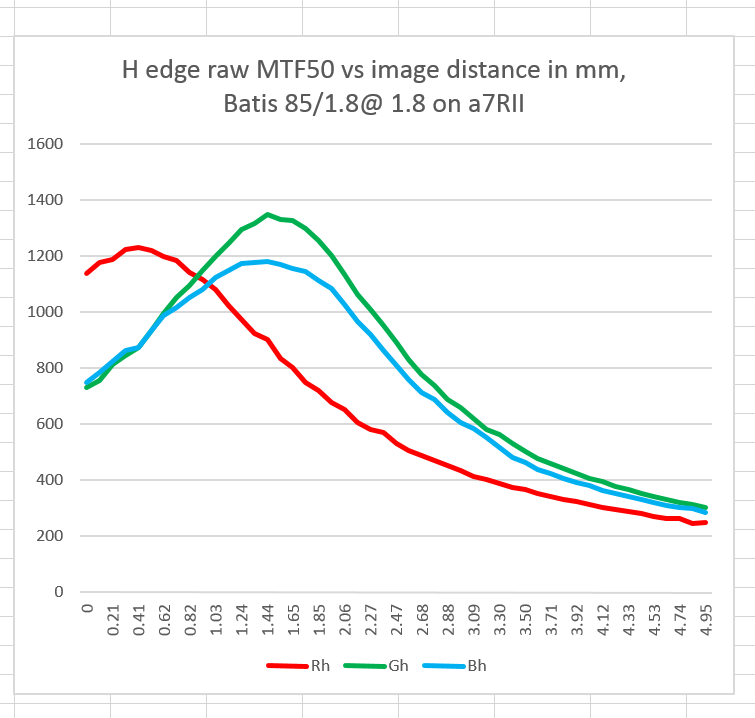This is a continuation of a test of the following lenses on the Sony a7RII:
- Zeiss 85mm f/1.8 Batis.
- Zeiss 85mm f/1.4 Otus.
- Leica 90mm f/2 Apo Summicron-M ASPH.
- AF-S Nikkor 85mm f/1.4 G.
- Sony 90mm f/2.8 FE Macro.
The test starts here.
I am now ready to start showing results for my longitudinal chromatic aberration LoCA) testing. Today we’ll start with the Batis, but I will show you results for the other four lenses in subsequent posts.
Before I get started, I’d like to send out a big “thank you” to Jack Hogan, with whom I sometimes collaborate on technical photographic projects. I had been looking at writing Matlab code to extract the data that I need for the on-axis LoCA studies from Imatest results, but Jack took pity on me and sent me Matlab code that does the following (Jack, if I get any of this wrong, please correct me):
- Uses DCRAW to decode, but not demosaic raw files
- Lets the user — moi — pick horizontal and vertical edges and regions for analysis
- Uses MTF Mapper to analyze the edges on a directory full of files
- Picks through the MTF Mapper results to report MTF50 values for the red, green, and blue raw planes, plus a white-balanced composite (I’m not using that last one).
So here’s what I did:
I lit the target with two Westcott LED panels, and set the color temperature to 5000K. I mounted a Sony a7RII with a Batis 85/1.8 on it to the Cognisys computer-driven focusing rail. I set the controller up to use 192mm of travel and make 49 exposures 4mm apart. I set the assembly 3.3 meters from the on-axis target, mounted the lens, focused a little towards the back from mid-rail using manual focusing, and exposed at 49-shot series from f/1.8 through f/8. I used Jack’s program to calculate the MTF50s for all the color planes, imported the data into Excel, and plotted the results in cycles per picture height vs distance from the point furthest away from the target.
Here’s what I got with a horizontal edge, wide open:
Distances closer to the target are on the right, and distances further away are on the left. You can see that the red plane is focused about 45mm further away from the target than the green and the blue planes. That is LoCA.
Referring all the measurements to the sensor side which just changes the horizontal axis, we get this:
Now the LoCA shows a shift that measures about 1 mm.
If we plot the data for the vertical edge in the same way, we get this:
You can see that the shift between the blue/green and the red curves is about the same, but that both are moved slight to the left. That is call astigmatism. Let’s ignore it for the purposes of this post.
Let’s look at the sensor-referred curves at f/2:
Not much difference.
At f/2.8:
We can see everything shifting to the right — that’s the focus shift we were seeing in the earlier posts == but the distance between the peaks seems to be staying constant.
At f/4:
The distance between the peaks is actually getting greater. The folk wisdom about LoCA is that it decreases as you stop down. That is not the case here. I have an explanation for that discrepancy that I’ll get to further on down the page.
At f/5.6:
The green and blue peaks are diverging slightly.
At f/8:
If the measure of LoCA is the distance between the point of sharp focus for three spectral mixes, than LoCA is not devreasing as you stop down with the Batis. However, as the depth of field gets greater and greater (the curves get flatter) the visibility of LoCA will decrease as you stop down.
More lenses to come.
Thanks, Jack!













Jim, is the x-axis mm or microns? As far as I can remember in-focus is usually measured in units of lambda.
Millimeters. Approx 85/3300 times subject distance shift. Did I do that right? It gets a bit more complicated as you get closer to the target.